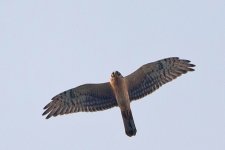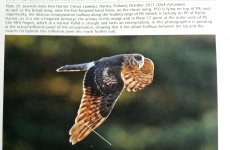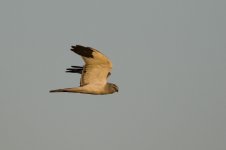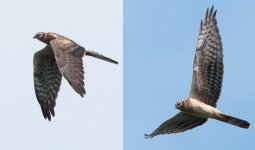On a much closer view there's really nothing wrong with primary pattern and primary formula for a Pallid. The p6 (counting from outwards and in from above lacks an emargination, which is present in Hen (which you of course know), and apparently in some hybrids, se pic below, which is from a Birding World article by Dick.F and David.E. I had a chat with Andreas Gullberg a well known expert when it comes to harriers. He thinks that the bird is a pale - presumable a male Pallid. He dig argue that the pale collar is narrow and the dark shawl is to streaked. He has seen some pale pallids showing the inner wing pattern but not all the mentioned features in one and the same individual.
Yes Jan, the biggest issue with the hybrid theory is the wing formula, indeed there is no indication of an emargination on P6. On some hybrids the 5th finger may be quite reduced and barely noticeable while the bird is flapping, see for instance the attached adult male hybrid from Belgium. But on the French bird the outer vane of P6 is well visible on one image and the absence of emargination undisputable.
My conclusion was that, while I was tempted by the hybrid label, I really couldn’t rule out an odd plumaged Pallid and that it may indeed be one.
The sum of odd plumage traits displayed by this bird really is amazing. And once again, the secondary pattern is to be noted, I don’t doubt Andreas honesty for a second when he says he has seen this secondary pattern in Pallid, but I would like to see a picture of such an individual to gauge it myself. I have spent a lot (a lot!) of time studying the plumage (including the secondary pattern) of harriers on photos and specimens and the pattern of the French bird is not only extremely peculiar but is also very much reminiscent of juv male Hen harrier, hence my doubt.
Another feature that hasn’t been mentioned in this thread so far is the fine, pencil-drawn, underparts streaking. The underparts pattern of juvenile Pallid is more variable than what is commonly acknowledged, but I am not sure I have this peculiar one before on a Pallid.
That said, them harrier never stop to amaze us and just when we think we have all figure it out and we have their identification under control…a bird pops up with a unique set of features pops up somewhere. See that extraordinary 1cy male Montagu’s photographed in Batumi a few years back…
So yes, a pure juv male Pallid with a plumage reminiscent of an adult female may well be the answer. Such individuals, recalling an ad female, are fairly regular in Hen harrier, the Batumi Montagu’s is the only example I know and I have never come across any example among Pallid before, but there is a first time for everything…








